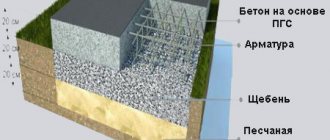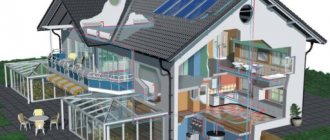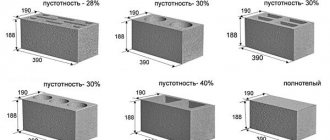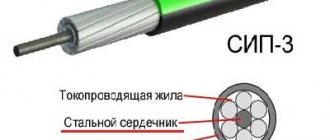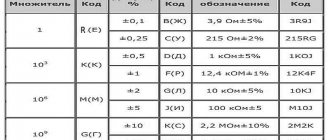Soil bearing capacity
The bearing capacity of soil is its basic characteristic that needs to be known when building a house; it shows how much load a unit area of soil can withstand and is measured in kg/cm2 or t/m2. The bearing capacity determines what the supporting area of the house's foundation should be: the worse the soil's ability to withstand the load, the larger the foundation area should be. The bearing capacity of the soil itself depends on three factors: the type of soil, the degree of its compaction and the saturation of the soil with moisture. The bearing capacities of different soils in kg/cm 2 in different states are presented in the table.
An increase in soil moisture reduces its bearing capacity several times. Only coarse and medium-sized sands do not change their properties with increasing humidity. Excessive soil moisture is most likely associated with high groundwater levels.
To find out the bearing capacity of the soil, it is not necessary to seek help from geologists; if you build a house yourself, you can determine the type of soil by eye. To do this, you can drill a hole 2 m deep in the ground with a simple earth drill or dig a hole with a shovel. In this case, it will immediately be clear what kind of soil is located at this depth and how moist it is.
It is not difficult to distinguish sand from clay: individual grains of sand are clearly visible in the sand, and when you rub sandy soil between your palms, you can clearly feel them. Coarse sand has a particle size from 0.25 to 5 mm, such particles are clearly visible to the naked eye, and medium-density sand has a grain size of up to 2 mm. Sandy loam contains no more than 10% clay particles; in a dry state it crumbles; if you roll a ball out of it, it will crumble with light pressure on it. Loam contains from 10% to 30% clay particles and has greater plasticity than sandy loam. If you make a ball out of loam and crush it, it turns into a flat cake with cracks along the edges. Clay is the most plastic soil; if you crush a ball made of clay, it will turn into a cake with no cracks at the edges.
You can also determine soil moisture by eye. If the dug hole or drilled well is dry, i.e. Water frankly does not accumulate there, which means the soil can be considered dry. If water accumulates at the bottom of the well after some time, then the groundwater level is close and the soil should be considered saturated with moisture. The moisture content and plasticity of clay can be determined as follows: if the shovel enters the clay easily and the clay adheres well to the shovel, then it is plastic and wet. Otherwise it can be considered dry. Soil density is not a constant value. The soil located deep underground will be dense because the layers of soil located above press on it. When drilling a well, the soil excavated to the surface of the earth becomes loose and has a bulk density that is much lower. When calculating the bearing capacity, soil located at a depth of 0.8-1 m or more can be considered dense.
Soil research does not always happen, and even with professional house design, such data may not be available. Therefore, for simplified and approximate calculations, the load-bearing capacity of the soil is often taken to be 2 kg/cm 2 .
Freezing of the soil leads to heaving and a negative impact on the foundation of the building. The depth of freezing depends on the type of soil and climatic conditions.
Clay soil is soil that is more than half composed of very small particles less than 0.01 mm in size, which are in the form of flakes or plates. Clay soils include sandy loam, loam and clay.
Groundwater is the first underground aquifer layer from the surface of the earth, which lies above the first impermeable layer. They have a negative impact on the properties of the soil and the foundations of houses; the groundwater level must be known and taken into account when laying the foundation.
Heaving soil is a soil that is susceptible to frost heaving; when it freezes, it increases significantly in volume. Heaving forces are quite strong and are capable of lifting entire buildings, so it is impossible to lay a foundation on heaving soil without taking measures against heaving.
At the design stage of the future house, among other calculations, it is necessary to perform a foundation calculation. The purpose of this calculation is to determine what load will act on the foundation and soil, and what the supporting area of the foundation should be. In order to determine the total load on the foundation, it is necessary to calculate the weight of the future house with all operational loads (people living there, furniture, engineering equipment, etc.)
Density meters are special construction instruments that can be used to measure the density of soil and evaluate its load-bearing capacity right on a construction site.
Ground support
The main function of the foundation was mentioned a little earlier - transferring loads to the ground. The figure below shows different types of foundations and their support schemes in order of increasing area.
As we can see from the pictures, the slab has the largest supporting area and, as a result, the smallest distributed weight per unit area. But is a slab the most versatile and reliable type of foundation? - No is not.
On water-saturated soils without work to lower the groundwater level or “weak” soils without excavation and replacement of the load-bearing layer, the slab, like other types of foundations, can crack. Also, the slab can crack due to uneven flooding and freezing of one of the corners or in the case when the foundation ends up on the boundaries of different soil layers with different bearing capacities. Which brings us back to the need to conduct geological surveys.
A few words about the USP, which is not on the load distribution diagram. Structurally, it is strip foundation with floors on the ground. The only difference is that the filler inside the tape is not sand, but polystyrene foam or extruded polystyrene foam. The main load-bearing part of such a foundation is the tape.
The picture shows a diagram of an insulated Swedish stove
It is also worth dispelling the myth regarding the support of a columnar, or in common people a pile-grillage, foundation. It transfers the load to the ground only by piles , hence the very small area. If such a foundation is supported, in addition to piles, by a grillage, then it turns into an ordinary shallow shallow foundation, and the piles into uselessly buried material.
It is also important to note the total mistake made by unskilled workers during the construction of a columnar foundation. It is described in paragraph 8 of the methodological manual “ Design of foundations and foundations on heaving soils ”:
When installing columnar foundations on heaving soils, it is necessary to provide a gap between the lower edge of the foundation beams and the leveling surface of the soil, the value of which must be no less than the calculated heaving (lifting) deformation of the unloaded foundation.
In other words, there must be a distance between the grillage and the soil that compensates for the deformation of the soil during frost heaving. The magnitude of these deformations, as well as how heaving and/or water-saturated the soil is, can be determined by geology.
Soil bearing capacity table snip
Table 3. Calculated resistance R0
silty-clayey (non-subsidence) soils.
Table 4. Calculated resistance R0
subsidence soils.
Note. The numerator shows the values of R0
, relating to unsoaked subsidence soils with a moisture level
Sr
≤0.5;
in the denominator are the R
o values related to the same soils with
Sr
≥3;0.8, as well as to soaked soils.
Table 5. Calculated resistance R0
bulk soils.
Note that the R0 values in Tables 1-5 refer to foundations with a width b0 = 1 m and a depth of d0 = 2 m.
As can be seen from the tables, in order to determine the bearing capacity of the soil, it is first important to accurately determine the type of soil. Moreover, it is not recommended to use traditional methods for this, such as rubbing lumps of soil, etc. Such an analysis may turn out to be erroneous. Geologists can accurately determine the type of soil and its bearing capacity. If there are no specialists, then usually the load-bearing capacity for insurance is often taken at a “bad” value (1-2 kg/cm 2 ). Trying to determine the soil “by eye” is risky.
The heavier the house, the more it puts pressure on the ground, so the pressure on the ground should not exceed the bearing capacity of the ground (i.e. soil resistance). If the design pressure exceeds the load-bearing capacity, then it is necessary to either reduce the weight of the house, or increase the area of contact with the ground, or change the soil.
What happens if the impact of the house's mass exceeds the bearing capacity of the soil? The soil can “move”, be squeezed out from under the foundation, settle unevenly, partially shift to the side, etc. And this means cracks in the foundation and further along the walls.
Example. Let's say a two-story brick house weighs 500 tons, i.e. 500,000 kilograms. If the bearing capacity of the soil under the house is 2 kg/cm 2, then the contact area of the foundation with the house must be at least:
500000 kg / 2 kg/cm2 = 250000 cm2 = 25 m2
This means that if the foundation is strip, then with its width, say, 0.5 m, the strip must have a total length of at least:
25 m2 / 0.5 m = 50 m.
Or vice versa, knowing the length of the tape, you can calculate the minimum width of the tape.
The calculation example above is a very simplified version. According to the above-mentioned SNiP 2.02.01-83*, the final value of the foundation soil resistance (R) is calculated using the following formulas:
at d ≤ 2 m (200 cm)
at d > 2 m (200 cm)
where: b and d are the width and depth of the designed foundation, respectively, m (cm); b0 and d0 - width 1 m (100 cm) and depth 2 m (200 cm); γ'II - calculated value of the specific gravity of the soil located above the base of the foundation, kN/m 3 (kgf/cm 3 ); k1 - coefficient accepted for foundations composed of coarse and sandy soils, except for silty sands, k1 = 0.125, silty sands, sandy loams, loams and clays k1 = 0.05; k2 - coefficient accepted for foundations composed of coarse and sandy soils k2 = 0.25, sandy loams and loams k2 = 0.2, clays k2 = 0.15
It is strongly not recommended to use chernozem as a foundation soil for a reinforced concrete foundation. This is organic matter with a weak load-bearing capacity. In some regions, black soil can go 2 meters deep. In this case, either trenches are dug to the full depth, or the excess black soil is replaced with a more durable base - sand and/or crushed stone.
A slab foundation has a much larger contact area with the ground, so this type of foundation is well suited for soil with weak bearing capacity.
I will be glad to see your comments on the topic of the article and any additions. Remember, the author is an ordinary person, I don’t always have time to answer if you ask a question about your construction project.
The bearing capacity of foundation soils is assessed together with foundations and ground structures. The purpose of bearing capacity calculations is to ensure the strength and stability of the foundation soils, as well as to prevent the foundation along the base and overturning.
Disruption of the normal operation of structures can occur not only due to the accumulation of excessive settlements, but also due to a violation of the strength of the foundation when significant vertical and horizontal loads are applied to the foundation. Thus, the maximum load that the soil without destruction is called bearing capacity of the soil .
The bearing capacity of the foundation is influenced by the following factors (according to M.V. Malyshev, 1994):
- type of load - vertical or inclined, with a horizontal component;
- eccentricity of the application of external load relative to the center of gravity of the foundation base area;
- dimensions of the foundation base;
- shape of the foundation base - rectangle, square, circle, strip foundation;
- deepening the foundation into the ground relative to the ground surface;
- horizontality or slope in relation to the horizon of the plane of the base of the foundation (for foundations that perceive shear force);
- horizontality or slope relative to the horizon of the day surface of the foundation around the foundation within the area in which soil can bulge from under the foundation;
- homogeneity of foundation soils, presence of a groundwater horizon;
- loading rate and other factors.
According to SNiP 2.02.01-83*, the bearing capacity of the foundation is considered ensured if the following conditions are met:
(8.58)
where F is the resultant of the design load on the base; γс is the operating conditions coefficient, taken from the table. 8.12
; Fu—the ultimate resistance force (resultant of the ultimate load) of the base; γn—reliability coefficient for the purpose of the structure, taken equal to 1.2; 1.15; 1.10 for buildings of classes I, II and III, respectively.
Table 8.12.
Working conditions coefficient values (SNiP 2.02.01—83*)
Soil bearing capacity table
The bearing capacity of the soil is determined based on a number of soil characteristics. In order to obtain all the necessary indicators, you will need to perform a series of tests. They will make it possible to find out the exact bearing capacity of the soil in a specific area. Corresponding experiments are carried out with soil obtained directly from the planned construction site.
What is the bearing capacity of soil?
Soil bearing capacity is a measure of the pressure that soil can withstand. It is indicated either in Newtons per square centimeter (N/cm²), or in kilogram-force per 1 square centimeter (kgf/cm²), or in megapascals (MPa).
This value is used when designing foundations to compare the load exerted on the soil by the building structure, taking into account the possible layer of snow on the roof and wind pressure on the surface of the walls. Even with an accurate calculation of the influence of each of these factors on the ratio of the bearing capacity of the ground surface on the site to the total load from the building structure, this figure is taken with a margin.
Table of average bearing capacity of various soils
The following is a table indicating the average bearing capacity or, as it is also called, the calculated resistance of different types of soil in kgf/cm².
More accurate calculations taking into account all the coefficients that reflect the influence of each factor existing in real conditions can be performed by following the recommendations in the normative set of rules for 2011 SP 22.13330.2011 with the title Foundations of buildings and structures. This is the official publication of the older standard SNiP 2.02.01-83 *, made by the N.M. Research Institute. Gersevanova.
The table below shows the average results of calculations carried out using formulas and data based on the 2011 set of rules described above.
Here you can see that there is a fairly large scatter in soil resistance values. This is primarily due to soil moisture, which directly depends on the level of groundwater.
If you need to obtain numbers in MPa or N/cm², then you can convert the values indicated in the table according to the established ratios of values.
- 1 kgf/cm² = 0.098 MPa or 1 MPa = 10.2 kgf/cm²
- 1 kgf/cm² = 9.8 N/cm² or 1 N/cm² = 0.102 kgf/cm²
For convenience, there is also a table showing the average figures for the calculated soil resistance in N/cm²
A similar problem with these types of tables is the very significant difference between the minimum and maximum values. In general, it is recommended to take the minimum indicators that are indicated in the tabular data. As an example, we will place another table that clearly illustrates the approach of foreign specialists to the publication of their research data.
Obviously, tabular figures are used, as a rule, by those who have decided not to order a professional geological soil survey on their site. Therefore, it makes sense to give indicators with a margin, so that during independent calculations, even if a small error creeps into them, this will not lead to irreparable consequences.
At the same time, even with a significant margin of safety, it is not a fact that the building structure will stand quite stably on its foundation for decades. During this period, the quality of the soil may change if appropriate measures have not been taken to protect the foundation from the accumulation of sedimentary water. For these purposes, it is imperative to make a blind area with good waterproofing and a drainage system around the perimeter of the building for centralized collection of wastewater.
Updated table with corrections for soil fluidity and porosity
There is another table of bearing capacity that allows you to more accurately determine the numbers on the site where the porosity coefficients and soil fluidity indicators are known.
The influence of the soil fluidity coefficient on its bearing capacity is shown in the table. The average fluidity of soil depends on its type and water saturation coefficient. These calculations are quite difficult to perform, so we post tables that describe the behavior of the soil sample, characterizing its fluidity.
Also, the calculated resistance depends on the porosity coefficient E, which must be established using experimental sampling directly at the future construction site.
For the test, you will need to take a cube of soil 10x10x10 cm with a volume O1 = 1000 cm³ so that it does not crumble. Next, this cube is weighed and its mass (M) is determined, after which the soil is crushed. Then, using a measuring cup, the volume of crushed soil is determined, also in cubic centimeters (O2).
Next, you need to find out the volumetric weight of the original cube (OB1) and crushed soil without pores (OB2). To do this, you should first divide the mass (M) determined by (O1) to get (OB1) and then divide the same value (M) by (O2) to get (OB2). The initial volume O1 is initially known and equal to 1000 cm³, and the volume of crushed soil O2 is taken from the experiment with a measuring cup.
All that remains is to calculate the porosity E, which is equal to 1 - (OB1/OB2)
Now, knowing the fluidity coefficient and porosity of the soil, based on the tabular figures, you can say with a certain accuracy what bearing capacity is calculated specifically for your site. If you used experimental determination of porosity, then make sure that at least 3 experiments were carried out to obtain the desired value with a sufficiently high accuracy. If you want to get data as close to reality as possible, use a special calculator, where you can indicate all the coefficients that affect the final figure here.
Bearing capacity of soil and ways to increase it
Construction is a complex process that requires great precision when calculating the load-bearing capacity of a structure.
The mass of the roof transfers the load to the walls, then to the foundation, and ultimately the mass of the entire structure acts on the foundation - the thickness of the rock on which the foundation rests.
Before starting construction, it is necessary to check the reliability of the soil.
The bearing capacity of soil is the load acting per unit of its volume and not leading to deformation of the base .
What does load-bearing capacity depend on?
To determine the bearing capacity of the soil, specialists conduct geological surveys. Several wells are drilled on the construction site, samples are taken from them at equal distances, laboratory tests are carried out and a report is drawn up.
Several factors influence load-bearing capacity :
- Type of soil;
- Layer thickness;
- Depth of occurrence;
- Characteristics of the previous layer;
- Groundwater level (GWL);
- Soil freezing depth;
- Density.
During construction, the most important indicator is groundwater level; soil moisture depends on it.
In a dry and moisture-saturated state, the same rocks have different characteristics that differ several times.
Any soil that comes into contact with water is considered saturated with moisture.
This increases their fluidity and reduces their load-bearing capacity.
The exception is medium and coarse sands. Their properties do not change due to saturation with water.
Density is a measure of porosity .
The soil consists of solid particles, between which there are hollow spaces filled with air or water. When the maximum possible load is exceeded, deformation (shrinkage) occurs, which can completely destroy the building.
Dense rocks with a minimum number of voids are considered the most durable. The shrinkage of such soils is minimal.
Occurrence
When designing a building, it is very important to examine the thickness of the soil below the proposed base of the foundation . Fragile rocks lie close to the surface and can only withstand the load of a small building. The deeper the rock lies, the older, denser, thicker and more reliable it is.
Depending on the location and type of soil, a foundation installation plan will be developed in accordance with the rules :
- Laying the foundation near the boundary of different rocks is not allowed;
- It is advisable to install the foundation above the groundwater level; if this is not possible, measures are taken to waterproof the structures;
- A horizontal layer is ideal for installing a foundation.
The bearing capacity of the foundation will be reduced in places where rocks change, near the groundwater level, and on slopes.
Rice. 1 Example of engineering-geological section
In the drawing, the rocks are indicated by different shading, the heights of the wellheads are indicated, and the groundwater level line is drawn.
Soil types
There are several types of rocks with special characteristics:
- Rocky , with high density and load-bearing capacity;
- Coarse clastics . Consist of individual large particles;
- Sandy . Non-plastic soils that can withstand heavy loads;
- Clayey . Cohesive soils easily absorb moisture and swell when frozen.
Rocky
Rocks are formed as a result of volcanic eruptions and the subsequent solidification of magma in the earth.
Due to this, a rock with low porosity and rigid bonds between particles is formed.
It is characterized by great strength, resistance to negative temperatures, does not absorb water, and does not heave.
If there are no cracks in the rock, it does not wash out and deteriorates very slowly over time.
Rocks are ideal as a base for any object . But they are very rarely used for construction, because they are found mainly at great depths or in hard-to-reach areas.
Coarse clastic
Coarse soils are loose rocks consisting of a thickness of stones (rock fragments), most of which are larger than 2 mm. Packed boulders and debris that are not subject to washing out are a good basis.
There are several types of coarse clastic rocks:
- Gravel . Most of the debris is 2–40 mm in size. A distinction is made between gravel (rounded fragments) and gruss (angular fragments);
- Pebbles (rounded parts) and crushed stone (angular parts). At least 50% of the soil mass is represented by fragments from 40 to 100 mm;
- Boulders . The size of each fragment exceeds 100 mm.
Sandy
In a state unsaturated with water, sand is free-flowing, but compacted sandstone is a reliable base that does not change its properties when saturated with moisture . Sandy rocks do not heave and allow water to pass through well without retaining it near structures.
There are several types of sandstones:
- Dusty . Fraction size 0.005–0.050 mm;
- Small . The size of sand grains varies from 0.050 to 1.0 mm;
- Large . Grains up to 2 mm in size.
The most reliable foundations are compacted coarse rocks and coarse sand.
Clayey
Rock consisting of very small interconnected particles up to 0.005 mm in size is called clayey. Weathered tiny particles of scaly rocks form a mass of soil that can quickly absorb water. As a result, the rock becomes plastic.
Clay loses moisture with difficulty; when cold weather sets in, the water inside it freezes, increases in volume, and the clay bulges. This process can destroy the foundation in just one winter.
Types of Soil Rocks
The main regulatory document, which outlines the characteristics of soils, their types and classification, is GOST 25100-2011.
It should be noted that the most important property of such formations is the ability to change their physical properties based on environmental conditions. Temperature, density, humidity level, heterogeneity - all this directly affects the soil, changing its characteristics, which is necessarily taken into account when making calculations.
When analyzing soil for the foundation of a building, classification by structure and composition is most often used, which makes it possible to identify the required properties.
Rocky
These include shales, quartzites, diorites, granites, conglomerates, gneisses and sandstones.
They cope well with compressive loads, maintaining their strength and structure even in a moisture-saturated state.
The main difficulty is development, but in many cases a house can be built on it without the need for burial.
Coarse clastic
Unconsolidated soils that contain over 50% sedimentary and crystalline rocks, including boulders, gravel (crusher) and crushed stone, with a fraction of 3 to 40 mm.
They represent a good and strong foundation, although they are complex in terms of development, requiring the use of special technological equipment.
Sandy
They consist of coarse, medium and fine sand, the grains of which have good plasticity.
Due to good water permeability, they are practically not subject to heaving, representing a good foundation for buildings of various types and number of storeys. The larger the sand particles, the more dense it is.
Clayey
Plastic soils consisting of a mixture of sand and clay, the particles of which have a scaly shape, high capillarity and extremely low water permeability.
As a result, such compositions have a high degree of heaving in winter, which leads to the risk of pushing out the foundation. When dry, clay deposits are hard and retain their shape well, but when wet they are plastic and sticky due to easy liquefaction and moistening.
Due to their high mobility, quicksand cannot be used as a foundation when laying a structure.
Loess-like loams are one of the types of soil with clay impurities.
They are characterized by the presence of 15 to 30% plastic particles, when rubbed small grains of sand are visually visible.
When wet, loams have weak stickiness and plasticity; When the sample is rolled into a ball and then crushed, deep cracks form on it.
